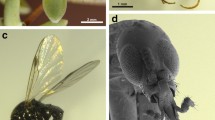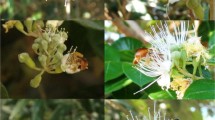Abstract
At Visakhapatnam (17°42′N-82°18′E),Moringa oleifera Lam. flowers twice a year, once during February–May and again during September–November. Both geitonogamous and xenogamous pollinations produce fruit, but the latter mode is superior. The flowers are zygomorphic and gullet type. They open during 0300–1900 h, and are visited only by diurnally active insects during 0600–1500 h. Bees are the dominant foragers, of whichXylocopa andAmegilla carry pollen on the head and/or thorax to effect nototribic pollination.Xylocopa was more frequent and proved to be the major pollinator.
Similar content being viewed by others
References
Anonymous 1962The wealth of India. Raw materials Vol. 6 (New Delhi: CSIR)
Baker H G and Baker I 1973 Some anthecological aspects of the evolution of nectar producing flowers, particularly amino acid production in nectar; inTaxonomy and ecology (ed.) V H Heywood (London: Academic Press) pp. 243–281
Barrows E M 1980 Robbing of exotic plants by introduced carpenter and honey bees in Hawaii, with comparative notes;Biotropica 12 23–29
Bawa K S 1976 Breeding of tropical hard woods; an evaluation of underlying bases, current status and future prospects; inTropical trees: Variation, breeding and conservation (eds) J Burley and B T Styles (London: Academic Press) pp 43–59
Bawa K S 1983 Patterns of flowering in tropical plants; inHandbook of experimental pollination biology (eds) C F Jones and R J Little (New York: Von Nostrand Reinhold Co.) pp 395–410
Cruden R W 1977 Pollen-ovule ratios: A conservative indicator of breeding systems in the flowering plants;Evolution 31 32–46
Cruden R W, Hermann H M and Peterson S 1983 Patterns of nectar production and plant-pollinator coevolution; inThe biology of nectaries (eds) Barbara Bentley and Thomas Elias (New York: Columbia University Press) pp 80–125
Ewusie J Y 1980Elements of tropical ecology (London: Heinemann Educational Books Ltd.)
Faegri K and Pijl L Van Der 1979The principles of pollination ecology (Oxford: Pergamon Press)
Frankie G W 1976 Pollination of widely dispersed trees by animals in Central America, with an emphasis on bee pollination systems; inTropical trees: Variation, breeding and conservation (eds) J Burley and B T Styles (London, New York: Academic Press) pp 151–159
Frankie G W, Baker H G and Opler P A 1974 Comparative phenological studies of trees in tropical wet and dry forests in the lowlands of Costa Rica;J. Ecol. 62 881–919
Frankie G W, Haber W A, Opler P A and Bawa K S 1983 Characteristics and organisation of the large bee pollination system in the Costa Rican dry forest; inHandbook of experimental pollination biology (eds) C E Jones and R J Little (New York: Von Nastrand Reinhold Co.) pp 411–447
Gentry A H 1974 Coevolutionary patterns in Central American Bignoniaceae;Ann. Mo. Bot. Gard. 61 728–759
Grant V 1950 The protection of the ovules in flowering plants;Evolution 4 179–201
Groat T B 1969 Seasonal flowering behaviour in Central Panama;Ann. Mo. Bot. Gard 56 295–307
Harborne J B 1973Phytochemical methods (London: Chapman and Hall)
Janzen D H 1964 Notes on the behaviour of flower subspecies of the carpenter beeXylocopa (Notoxylocopa)tabaniformis in Mexico;Ann. Entomol. Soc. Am. 57 296–301
Janzen D H 1971 Euglossine bees as long-distance pollinators of tropical plants;Science 171 203–205
Krishna Raju K S R 1985A contribution to the ornithology of Visakhapatnam region (with the check list of birds) (Visakhapatnam: The Kingfisher Andhra Pradesh Natural History Society)
Opler P A, Frankie G W and Baker H W 1980 Comparative phenological studies of treelet and shrub species in tropical wet and dry forests in the lowlands of Costa Rica;J. Ecol. 68 167–188
Pijl L Van Der 1954 Xylocopa and flowers in the tropics: I–II;Proc. K. Ned. Akad. Wet. C 57 413–423
Pijl L Van Der 1960a Ecological aspect of flower evolution I;Evolution 14 403–416
Pijl L Van Der 1960b Ecological aspect of flower evolution II;Evolution 15 44–59
Reddi E U B and Subba Reddi C 1983 Pollination ofJatropha gossypiifolia (Euphorbiaceae);Proc. Indian Acad. Sci. (Plant Sci.) 92 215–231
Salim Ali A 1932 Flower-birds and bird-flowers in India; inA century of natural history 1983 (ed.) J C Daniel (Bombay: Bombay Natural History Society)
Subba Reddi C and Reddi E U B 1984 Wind pollination in two tropical tree species of Euphorbiaceae;Proc. Indian Natl. Sci. Acad. B 50 66–80
Subba Reddi C and N S 1986 Pollen production in some anemophilous angiosperms;Grana 25 55–61
Subba Reddi C, Reddi E U B, Reddi N S and Reddi P S 1983 Reproductive ecology ofSapindus emarginatus (Sapindaceae);Proc. Indian Natl. Sci. Acad. B49 57–72
Author information
Authors and Affiliations
Rights and permissions
About this article
Cite this article
Jyothi, P.V., Atluri, J.B. & Reddi, C.S. Pollination ecology ofMoringa oleifera (Moringaceae). Proc. Indian Acad. Sci. 100, 33–42 (1990). https://doi.org/10.1007/BF03053466
Received:
Revised:
Issue Date:
DOI: https://doi.org/10.1007/BF03053466




